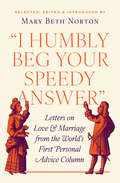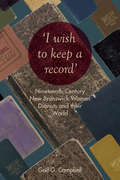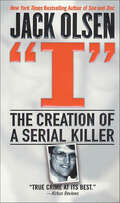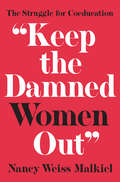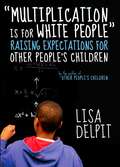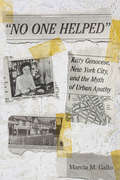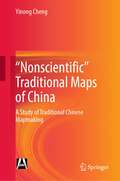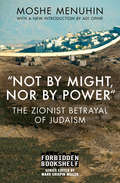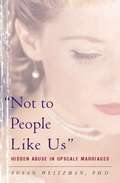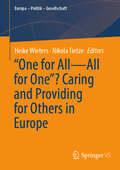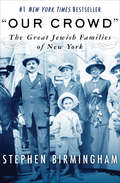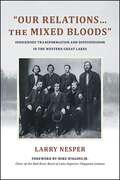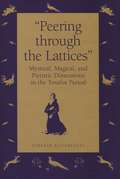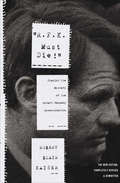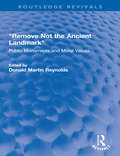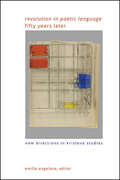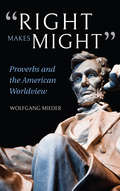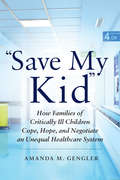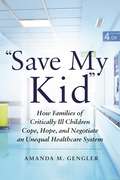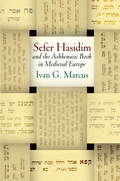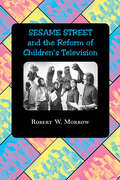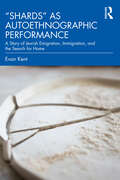- Table View
- List View
"I Humbly Beg Your Speedy Answer": Letters on Love and Marriage from the World’s First Personal Advice Column
by Mary Beth NortonA fascinating collection of questions and answers—about courtship, marriage, love, and sex—from a seventeenth-century periodical The Athenian Mercury—a one-page, two-sided periodical published in 1690s London—included the world&’s first personal advice column. Acclaimed historian and Pulitzer Prize–finalist Mary Beth Norton&’s &“I Humbly Beg Your Speedy Answer&” is a remarkable collection of questions and answers drawn from this groundbreaking publication.In these exchanges, anonymous readers look for help with their most intimate romantic problems—about courting, picking a spouse, getting married, securing or avoiding parental consent, engaging in premarital sex and extramarital affairs, and much more. Spouses ask how to handle contentious marriages and tense relationships with in-laws. Some correspondents seek ways to ease a conscience troubled by romantic and sexual misbehavior. The lonely wonder how to meet a potential partner—or how to spark a warmer relationship with someone they already have an eye on. And both men and women inquire about how to extract themselves from relationships turned sour. Many of these concerns will be familiar to readers of today&’s advice columns. But others are delightfully strange and surprising, reflecting forgotten social and romantic customs and using charmingly unfamiliar language in which, for example, &“kissing is a luscious diet,&” a marriage might provide &“much love and moderate conveniency,&” and an &“amorous disposition&” can lead to trouble.Delightful and entertaining, &“I Humbly Beg Your Speedy Answer&” provides a unique, intriguing, and revealing picture of what has—and hasn&’t—changed over the past three centuries when it comes to love, sex, and relationships.
"I wish to keep a record": Nineteenth-Century New Brunswick Women Diarists and Their World
by Gail CampbellNineteenth-century New Brunswick society was dominated by white, Protestant, Anglophone men. Yet, during this time of state formation in Canada, women increasingly helped to define and shape a provincial outlook. I wish to keep a record is the first book to focus exclusively on the life-course experiences of nineteenth-century New Brunswick women. Gail G. Campbell offers an interpretive scholarly analysis of 28 women’s diaries while enticing readers to listen to the voices of the diarists. Their diaries show women constructing themselves as individuals, assuming their essential place in building families and communities, and shaping their society by directing its outward gaze and envisioning its future. Campbell’s lively analysis calls on scholars to distinguish between immigrant and native-born women and to move beyond present-day conceptions of such women’s world. This unique study provides a framework for developing an understanding of women's worlds in nineteenth-century North America.
"I": The Creation of a Serial Killer
by Jack OlsenThe prize-winning, bestselling journalist provides a fascinating glimpse into the mind of “The Happy Face Killer” in the serial murderer’s own words . . .In February 1990, Oregon State Police arrested John Sosnovke and Laverne Pavlinac for the vicious rape and murder of Taunja Bennet, a troubled twenty-three-year-old barfly who had a mild intellectual disability since birth. There was just one problem. They had the wrong people.And the real killer wasn’t about to let anyone take credit for his kill. Keith Hunter Jesperson was a long-haul truck driver and the murderer of eight women, including Taunja Bennet. As the case wound through police precincts and courts—ending in life sentences for both Sosnovke and Pavlinac—Jesperson began a twisted one-man campaign to win their release. To the editors of newspapers and on the walls of highway rest stops, Jesperson scribbled out a series of taunting confessions. At the end of each admission, Jesperson drew a happy face, earning for himself the grisly sobriquet “The Happy Face Killer.”Based on access to interviews, diaries, court records, and the criminal himself, I: The Creation of a Serial Killer is Jesperson’s chilling story. It chronicles his evolution from angry child to sociopathic murderer, from tormentor of animals to torturer of women. It is also the story of the fate that befell him after two innocent citizens were imprisoned four years for one of his killings.In I: The Creation of a Serial Killer, Edgar Award winner Jack Olsen lets Jesperson tell his story in his own words, offering unprecedented insight into the twisted thought process of a serial murderer.
"I'm Not a Racist, But . . .": The Moral Quandary of Race
by Lawrence BlumNot all racial incidents are racist incidents, Lawrence Blum says. "We need a more varied and nuanced moral vocabulary for talking about the arena of race. We should not be faced with a choice of 'racism' or nothing." Use of the word "racism" is pervasive: An article about the NAACP's criticism of television networks for casting too few "minority" actors in lead roles asks, "Is television a racist institution?" A white girl in Virginia says it is racist for her African-American teacher to wear African attire. Blum argues that a growing tendency to castigate as "racism" everything that goes wrong in the racial domain reduces the term's power to evoke moral outrage. In "I'm Not a Racist, But . . .", Blum develops a historically grounded account of racism as the deeply morally-charged notion it has become. He addresses the question whether people of color can be racist, defines types of racism, and identifies debased and inappropriate usages of the term. Though racial insensitivity, racial anxiety, racial ignorance and racial injustice are, in his view, not "racism," they are racial ills that should elicit moral concern. Blum argues that "race" itself, even when not serving distinct racial malfeasance, is a morally destructive idea, implying moral distance and unequal worth. History and genetic science reveal both the avoidability and the falsity of the idea of race. Blum argues that we can give up the idea of race, but must recognize that racial groups' historical and social experience has been shaped by having been treated as if they were races.
"Jesus Saved an Ex-Con": Political Activism and Redemption after Incarceration (Religion and Social Transformation #9)
by Edward Orozco FloresAn examination of the efforts of faith-based organizations to expand the rights of the formerly incarcerated The use of religion to rehabilitate and redeem formerly incarcerated individuals has been a cultural touchstone of the modern era. Yet religious outreach to those with criminal records has typically been associated with an emphasis on private spirituality, with efforts focused on repentance, conversion, and restorative justice. This book sheds light on how faith-based organizations utilize the public arena, mobilizing to expand the social and political rights of former inmates. In “Jesus Saved an Ex-Con,” Edward Orozco Flores profiles Community Renewal Society and LA Voice, two faith-based organizations which have actively waged community organizing campaigns to expand the rights of people with records. He illuminates how these groups help the formerly incarcerated re-enter broader communities through the expansion of citizenship rights and participation in civic engagement. Most work on prisoner reentry has focused on how the behavior of those with records may be changed through interventions, rather than considering how those with records may change the society that receives them. Flores explores how the formerly incarcerated use redemption scripts to participate in civic engagement, to remove the felony conviction question from employment applications and to restrict the use of criminal background checks in housing and employment. He shows that people with records can redeem themselves while also challenging and changing the way society receives them.
"Keep the Damned Women Out": The Struggle for Coeducation (The William G. Bowen Memorial Series in Higher Education)
by Nancy Weiss MalkielAs the tumultuous decade of the 1960s ended, a number of very traditional, very conservative, highly prestigious colleges and universities in the United States and the United Kingdom decided to go coed, seemingly all at once, in a remarkably brief span of time. Coeducation met with fierce resistance. As one alumnus put it in a letter to his alma mater, "Keep the damned women out." Focusing on the complexities of institutional decision making, this book tells the story of this momentous era in higher education--revealing how coeducation was achieved not by organized efforts of women activists, but through strategic decisions made by powerful men.In America, Ivy League schools like Harvard, Yale, Princeton, and Dartmouth began to admit women; in Britain, several of the men's colleges at Cambridge and Oxford did the same. What prompted such fundamental change? How was coeducation accomplished in the face of such strong opposition? How well was it implemented? Nancy Weiss Malkiel explains that elite institutions embarked on coeducation not as a moral imperative but as a self-interested means of maintaining a first-rate applicant pool. She explores the challenges of planning for the academic and non-academic lives of newly admitted women, and shows how, with the exception of Mary Ingraham Bunting at Radcliffe, every decision maker leading the charge for coeducation was male.Drawing on unprecedented archival research, "Keep the Damned Women Out" is a breathtaking work of scholarship that is certain to be the definitive book on the subject.
"Multiplication Is for White People"
by Lisa DelpitAs MacArthur award-winning educator Lisa Delpit reminds us-and as all research shows-there is no achievement gap at birth. In her long-awaited second book, Delpit presents a striking picture of the elements of contemporary public education that conspire against the prospects for poor children of color, creating a persistent gap in achievement during the school years that has eluded several decades of reform.Delpit's bestselling and paradigm-shifting first book, Other People's Children, focused on cultural slippage in the classroom between white teachers and students of color. Now, in "Multiplication is for White People", Delpit reflects on two decades of reform efforts-including No Child Left Behind, standardized testing, the creation of alternative teacher certification paths, and the charter school movement-that have still left a generation of poor children of color feeling that higher educational achievement isn't for them.In chapters covering primary, middle, and high school, as well as college, Delpit concludes that it's not that difficult to explain the persistence of the achievement gap. In her wonderful trademark style, punctuated with telling classroom anecdotes and informed by time spent at dozens of schools across the country, Delpit outlines an inspiring and uplifting blueprint for raising expectations for other people's children, based on the simple premise that multiplication-and every aspect of advanced education-is for everyone.
"No One Helped": Kitty Genovese, New York City, and the Myth of Urban Apathy
by Marcia M. GalloIn "No One Helped" Marcia M. Gallo examines one of America's most infamous true-crime stories: the 1964 rape and murder of Catherine "Kitty" Genovese in a middle-class neighborhood of Queens, New York. Front-page reports in the New York Times incorrectly identified thirty-eight indifferent witnesses to the crime, fueling fears of apathy and urban decay. Genovese's life, including her lesbian relationship, also was obscured in media accounts of the crime. Fifty years later, the story of Kitty Genovese continues to circulate in popular culture. Although it is now widely known that there were far fewer actual witnesses to the crime than was reported in 1964, the moral of the story continues to be urban apathy. "No One Helped" traces the Genovese story's development and resilience while challenging the myth it created. "No One Helped" places the conscious creation and promotion of the Genovese story within a changing urban environment. Gallo reviews New York's shifting racial and economic demographics and explores post-World War II examinations of conscience regarding the horrors of Nazism. These were important factors in the uncritical acceptance of the story by most media, political leaders, and the public despite repeated protests from Genovese's Kew Gardens neighbors at their inaccurate portrayal. The crime led to advances in criminal justice and psychology, such as the development of the 911 emergency system and numerous studies of bystander behaviors. Gallo emphasizes that the response to the crime also led to increased community organizing as well as feminist campaigns against sexual violence. Even though the particulars of the sad story of her death were distorted, Kitty Genovese left an enduring legacy of positive changes to the urban environment.
"Nonscientific” Traditional Maps of China: A Study of Traditional Chinese Mapmaking
by Yinong ChengThis book analyzes the drawing data and methods of the Chinese ancient maps that are neglected by the previous researches, and reevaluates the drawing theories and methods, the influences, and accuracy of the maps that represents the scientificity of Chinese ancient cartographic drawings.
"Not by Might, Nor by Power": The Zionist Betrayal of Judaism (Forbidden Bookshelf #22)
by Moshe MenuhinWith a new introduction by Adi Ophir: An early and fierce critique of Zionism from a Jewish child of Palestine who argued against nationalism and injustice. Born in 1893, Moshe Menuhin was part of the inaugural class to attend the first Zionist high school in Palestine, the Herzliya gymnasium in Tel Aviv. He had grown up in a Hasidic home, but eventually rejected orthodoxy while remaining dedicated to Judaism. As a witness to the evolution of Israel, Menuhin grew disaffected with what he saw as a betrayal of the Jews&’ spiritual principles. This memoir, written in 1965, is considered the first revisionist history of Zionism. A groundbreaking document, it discusses the treatment of the Palestinians, the effects of the Holocaust, the exploitation of the Mizrahi Jewish immigrants, and the use of propaganda to win over public opinion in America and among American Jews. In a postscript added after the Six-Day War, Menuhin also addresses the question of occupation. This new edition is updated with an introduction by Israeli philosopher Adi Ophir, putting Menuhin&’s work into a contemporary historical context. Passionate and sometimes inflammatory in its prose, and met with controversy and anger upon its original publication under the title The Decadence of Judaism in Our Time, Menuhin&’s polemic remains both a thought-provoking reassessment of Zionist history and a fascinating look at one observer&’s experience of this embattled corner of the world over the course of several tumultuous decades.
"Not to People Like Us": Hidden Abuse in Upscale Marriages
by Susan WeitzmanHow is it possible for a highly educated woman with a career and resources of her own to stay in a marriage with an abusive husband? How can a man be considered a pillar of his community and regularly give his wife a black eye? The very nature of these questions proves how convinced we are that domestic violence is restricted to the lower classes. Now Susan Weitzman explores a heretofore overlooked population of battered wives-the upper-educated and upper-income women who rarely report abuse and remain trapped by their own silence.
"One for All—All for One”? Caring and Providing for Others in Europe (Europa – Politik – Gesellschaft)
by Heike Wieters Nikola TietzeThis book focusses on how historical dynamics and specific actors have shaped the diverse outlook and everyday practice of welfare in and across Europe. Based on the concept that narratives about welfare in Europe are intricately interconnected with various practices of &“caring&” for oneself and others, the authors take a praxeological approach to analyze specific care activities, the relevant players, and underlying narratives about welfare in Europe in the fields of housing, family provision, social insurance, child care, handling disability, dealing with poverty, and the transition of socialist welfare to the post 1989 world. Welfare is conceptualized as a field of changing relations of co-operation and competition between interest groups (such as labor unions, employers&’ groups, and churches), public government players, and other societal actors (such as social reformers, occupational groups, or NGOs). The volume contributes to the construction of a European multidimensional welfare geography that transcends state institutions and is defined by locally, regionally, nationally, transnationally negotiated and interconnected practices and traditions of caring and providing for others.
"Our Crowd": The Great Jewish Families of New York (Modern Jewish History Ser.)
by Stephen BirminghamThe #1 New York Times bestseller that traces the rise of the Guggenheims, the Goldmans, and other families from immigrant poverty to social prominence. They immigrated to America from Germany in the nineteenth century with names like Loeb, Sachs, Seligman, Lehman, Guggenheim, and Goldman. From tenements on the Lower East Side to Park Avenue mansions, this handful of Jewish families turned small businesses into imposing enterprises and amassed spectacular fortunes. But despite possessing breathtaking wealth that rivaled the Astors and Rockefellers, they were barred by the gentile establishment from the lofty realm of &“the 400,&” a register of New York&’s most elite, because of their religion and humble backgrounds. In response, they created their own elite &“100,&” a privileged society as opulent and exclusive as the one that had refused them entry. &“Our Crowd&” is the fascinating story of this rarefied society. Based on letters, documents, diary entries, and intimate personal remembrances of family lore by members of these most illustrious clans, it is an engrossing portrait of upper-class Jewish life over two centuries; a riveting story of the bankers, brokers, financiers, philanthropists, and business tycoons who started with nothing and turned their family names into American institutions.
"Our Relations…the Mixed Bloods": Indigenous Transformation and Dispossession in the Western Great Lakes (SUNY series, Tribal Worlds: Critical Studies in American Indian Nation Building)
by Larry NesperIn the Great Lakes region of the nineteenth century, "mixed bloods" were a class of people living within changing indigenous communities. As such, they were considered in treaties signed between the tribal nations and the federal government. Larry Nesper focuses on the implementation and long-term effects of the mixed-blood provision of the 1854 treaty with the Chippewa of Wisconsin. That treaty not only ceded lands and created the Ojibwe Indian reservations in the region, it also entitled hundreds of "mixed-bloods belonging to the Chippewas of Lake Superior," as they appear in this treaty, to locate parcels of land in the ceded territories. However, quickly dispossessed of their entitlement, the treaty provision effectively capitalized the first mining companies in Wisconsin, initiating the period of non-renewable resource extraction that changed the demography, ecology, and potential future for the region for both natives and non-natives. With the influx of Euro-Americans onto these lands, conflicts over belonging and difference, as well as community leadership, proliferated on these new reservations well into the twentieth century. This book reveals the tensions between emergent racial ideology and the resilience of kinship that shaped the historical trajectory of regional tribal society to the present.
"Peering Through the Lattices": Mystical, Magical, and Pietistic Dimensions in the Tosafist Period
by Ephraim KanarfogelDuring the high Middle Ages, the tosafists flourished in northern Europe and revolutionized the study of the Talmud. These Jewish scholars did not participate in the philosophical and religious thought that concerned Christendom, and today they are seen as having played a limited role in mystical or esoteric studies. Ephraim Kanarfogel now challenges this conventional view of the tosafists, showing that many individuals were influenced by ascetic and pietistic practices and were involved with mystical and magical doctrines. He traces the presence of these disciplines in the pre-Crusade period, shows how they are intertwined, and suggests that the widely available Hekhalot literature was an important conduit for this material. He also demonstrates that the asceticism and esotericism of the German Pietists were an integral part of Ashkenazic rabbinic culture after the failure of Rashbam and other early tosafists to suppress these aspects of pre-Crusade thinking. The identification of these various forms of spirituality places the tosafists among those medieval rabbinic thinkers who sought to supplement their Talmudism with other areas of knowledge such as philosophy and kabbalah, demonstrating the compatibility of rabbinic culture and mysticism. These interests, argues Kanarfogel, explain both references to medieval Ashkenazic rabbinic figures in kabbalistic literature and the acceptance of certain ascetic and mystical practices by later Ashkenazic scholars. Drawing on original manuscript research, Kanarfogel makes available for the first time many passages produced by lesser known tosafists and rabbinic figures and integrates the findings of earlier and contemporary scholarship, much of it published only in Hebrew. "Peering through the Lattices" provides a greater appreciation for these texts and opens up new opportunities for scholarhship in Jewish history and thought.
"R.F.K. Must Die!": Chasing the Mystery of the Robert Kennedy Assassination
by Robert Blair KaiserThe definitive text on the mystery of R.F.K.&’s assassination by a reporter who &“got inside this story . . . with his impressive grasp of all the loose ends&” (Kirkus Reviews). On the night of June 4, 1968, Sirhan Sirhan shot and killed Sen. Robert F. Kennedy in a steamy pantry of the Los Angeles Ambassador Hotel. Kennedy and his entourage had been celebrating his victory in the California primary for the Democratic nomination for president. Everybody knew that Sirhan was the assassin. But was there a wider conspiracy? Did the FBI truly solve the crime? After working his way deep inside the investigation—and spending more than two hundred hours in direct conversation with Sirhan—Robert Blair Kaiser wrote the quintessential book on Robert Kennedy&’s murder. Then, forty years later, Kaiser returned to the evidence, revising his original text as he probed even further into this mystifying tragedy. Widely recognized as an important contribution to the literature of political assassinations and as a primary document on the tragedy of Kennedy&’s death, &“R.F.K. Must Die!&” is more than ever a stunning look into the mind of a killer and the substance of an assassination.
"Remove Not the Ancient Landmark": Public Monuments and Moral Values (Routledge Revivals)
by Donald Martin ReynoldsFirst published in 1996, "Remove Not the Ancient Landmark" explores the ways that public monuments symbolize and convey moral values. It analyzes the roles that monuments have always played and the influence they continue to exert on societies around the world. The book also explores the origins and nature of humanity in light of the monuments.
"Revolution in Poetic Language" Fifty Years Later: New Directions in Kristeva Studies (SUNY series in Gender Theory)
by Emilia AngelovaIn her 1974 Revolution in Poetic Language, Julia Kristeva resisted the abstract use of language, with its aim of totalization and finality, in all its colonizing and alienating forms. A major thinker and critic, Kristeva reappropriated Hegel's concepts of desire and negativity, in conjunction with the thought of Heidegger, Arendt, Freud, and Lacan, to revolt against modernity's culture of nihilism and the West's inability to deal with loss. This collection celebrates the fiftieth anniversary of Revolution in Poetic Language by revisiting Kristeva's oeuvre and establishing exciting new directions in Kristeva studies. Engaging with queer and transgender studies, disability studies, decolonial studies, and more, renowned and rising scholars plot continuities in—and push the boundaries of—Kristeva's thinking about loss, revolution, and revolt. The volume also includes two essays by Kristeva, translated into English for the first time here—"The Impossibility of Loss" (1988) and "Of What Use Are Poets in Times of Distress?" (2016).
"Right Makes Might": Proverbs and the American Worldview
by Wolfgang Mieder“A powerful and timely addition to the literature of rhetoric and folklore.” —ChoiceIn 1860, Abraham Lincoln employed the proverb Right makes might—opposite of the more aggressive Might makes right—in his famed Cooper Union address. While Lincoln did not originate the proverb, his use of it in this critical speech indicates that the fourteenth century phrase had taken on new ethical and democratic connotations in the nineteenth century. In this collection, famed scholar of proverbs Wolfgang Mieder explores the multifaceted use and function of proverbs through the history of the United States, from their early beginnings up through their use by such modern-day politicians as Barack Obama, Hillary Rodham Clinton, and Bernie Sanders. Building on previous publications and unpublished research, Mieder explores sociopolitical aspects of the American worldview as expressed through the use of proverbs in politics, women’s rights, and the civil rights movement—and by looking at the use of proverbial phrases, Mieder demonstrates how one traditional phrase can take on numerous expressive roles over time, and how they continue to play a key role in our contemporary moment.
"Right Makes Might": Proverbs and the American Worldview
by Wolfgang Mieder“A powerful and timely addition to the literature of rhetoric and folklore.” —ChoiceIn 1860, Abraham Lincoln employed the proverb Right makes might—opposite of the more aggressive Might makes right—in his famed Cooper Union address. While Lincoln did not originate the proverb, his use of it in this critical speech indicates that the fourteenth century phrase had taken on new ethical and democratic connotations in the nineteenth century. In this collection, famed scholar of proverbs Wolfgang Mieder explores the multifaceted use and function of proverbs through the history of the United States, from their early beginnings up through their use by such modern-day politicians as Barack Obama, Hillary Rodham Clinton, and Bernie Sanders. Building on previous publications and unpublished research, Mieder explores sociopolitical aspects of the American worldview as expressed through the use of proverbs in politics, women’s rights, and the civil rights movement—and by looking at the use of proverbial phrases, Mieder demonstrates how one traditional phrase can take on numerous expressive roles over time, and how they continue to play a key role in our contemporary moment.
"Save My Kid": How Families of Critically Ill Children Cope, Hope, and Negotiate an Unequal Healthcare System
by Amanda M. GenglerA frank analysis of the medical and emotional inequalities that pervade the healthcare process for critically ill children Families who have a child with a life-threatening illness face a daunting road ahead of them, one that not only upends their everyday lives, but also strikes at the very heart of parenthood. In “Save My Kid,” Amanda M. Gengler traces the emotional difficulties these families navigate as they confront a fundamentally unequal healthcare system in the United States. Gengler reveals the unrecognized, everyday inequalities tangled up in the process of seeking medical care, showing how different families manage their children’s critical illnesses. She also uncovers the role that emotional goals—deeply rooted in the culture of illness and medicine—play in medical decision-making, healthcare interactions, and the end of children’s lives. A deeply compassionate read, “Save My Kid” is an inside look at inequality in healthcare among those with the most at stake.
"Save My Kid": How Families of Critically Ill Children Cope, Hope, and Negotiate an Unequal Healthcare System
by Amanda M. GenglerA frank analysis of the medical and emotional inequalities that pervade the healthcare process for critically ill children Families who have a child with a life-threatening illness face a daunting road ahead of them, one that not only upends their everyday lives, but also strikes at the very heart of parenthood. In “Save My Kid,” Amanda M. Gengler traces the emotional difficulties these families navigate as they confront a fundamentally unequal healthcare system in the United States. Gengler reveals the unrecognized, everyday inequalities tangled up in the process of seeking medical care, showing how different families manage their children’s critical illnesses. She also uncovers the role that emotional goals—deeply rooted in the culture of illness and medicine—play in medical decision-making, healthcare interactions, and the end of children’s lives. A deeply compassionate read, “Save My Kid” is an inside look at inequality in healthcare among those with the most at stake.
"Sefer Hasidim" and the Ashkenazic Book in Medieval Europe (Jewish Culture and Contexts)
by Ivan G. MarcusComposed in Germany in the early thirteenth century by Judah ben Samuel he-hasid, Sefer Hasidim, or "Book of the Pietists," is a compendium of religious instruction that portrays the everyday life of Jews as they lived together with and apart from Christians in towns such as Speyer, Worms, Mainz, and Regensburg. A charismatic religious teacher who recorded hundreds of original stories that mirrored situations in medieval social living, Judah's messages advocated praying slowly and avoiding honor, pleasure, wealth, and the lures of unmarried sex. Although he failed to enact his utopian vision of a pietist Jewish society, his collected writings would help shape the religious culture of Ashkenazic Judaism for centuries.In "Sefer Hasidim" and the Ashkenazic Book in Medieval Europe, Ivan G. Marcus proposes a new paradigm for understanding how this particular book was composed. The work, he contends, was an open text written by a single author in hundreds of disjunctive, yet self-contained, segments, which were then combined into multiple alternative versions, each equally authoritative. While Sefer Hasidim offers the clearest example of this model of composition, Marcus argues that it was not unique: the production of Ashkenazic books in small and easily rearranged paragraphs is a literary and cultural phenomenon quite distinct from anything practiced by the Christian authors of northern Europe or the Sephardic Jews of the south. According to Marcus, Judah, in authoring Sefer Hasidim in this manner, not only resisted Greco-Roman influences on Ashkenazic literary form but also extended an earlier Byzantine rabbinic tradition of authorship into medieval European Jewish culture.
"Sesame Street" and the Reform of Children's Television
by Robert W. Morrow“[An] accessible, well-researched introduction to the people and principles behind the show’s creation . . . Essential.” —Choice (An Outstanding Academic Title of the Year) By the late 1960s more than a few critics of American culture groused about the condition of television programming and, in particular, the quality and content of television shows for children. In the eyes of the reform-minded, commercial television crassly exploited young viewers; its violence and tastelessness served no higher purpose than the bottom line.The Children’s Television Workshop (CTW)—and its fresh approach to writing and producing programs for kids—emerged from this growing concern. Sesame Street—CTW’s flagship hour-long show—aimed to demonstrate how television could help all preschoolers, including low-income urban children, prepare for first grade. In this engaging study Robert W. Morrow explores the origins and inner workings of CTW, how the workshop in New York scripted and designed Sesame Street, and how the show became both a model for network television and a thorn in its side.Through extensive archival research and a systematic study of sample programs from Sesame Street’s first ten seasons, Morrow tells the story of Sesame Street’s creation; the ideas, techniques, organization, and funding behind it; its place in public discourse; and its ultimate and unfortunate failure as an agent of commercial television reform.“An insightful look at American children's television.” —Library Journal
"Shards" as Autoethnographic Performance: A Story of Jewish Emigration, Immigration, and the Search for Home
by Evan Kent"Shards" as Autoethnographic Performance explores the development, creation, and presentation of performed autoethnography. The author shares the impetus for the work’s creation and his method for writing and rehearsing performed autoethnography. This book is essentially an autoethnography about writing and performing an autoethnography and functions as a "play within a play." Through extensive discussions about the development, writing, and performance of "Shards," the author reveals how contemporary political events and social issues as well as events in his ancestors’ history impact his writing, research, and eventual performance. The author takes us on an autoethnographic journey encompassing early 20th-century immigration from Eastern Europe to the United States, his personal development as a singer and actor, the practically obsessive need to perform, his education and eventual employment as a cantor in a synagogue, and how he negotiates these personal and artistic conflicts. Throughout the book, Evan shares with the reader highly personal stories of great honesty, sincerity, and candor. The book also provides insight into performing during the COVID-19 pandemic and how performing artists (including the author) utilized online performing venues. This book would be a good companion volume for classes in qualitative research, autoethnography, and performance studies, as well as for those looking for a guide on writing, rehearsing, and performing solo theatre.
